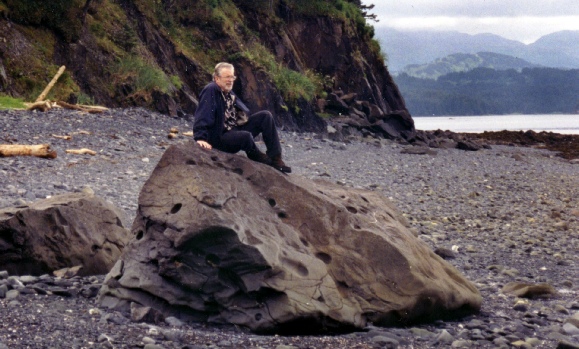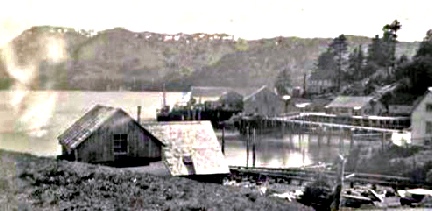
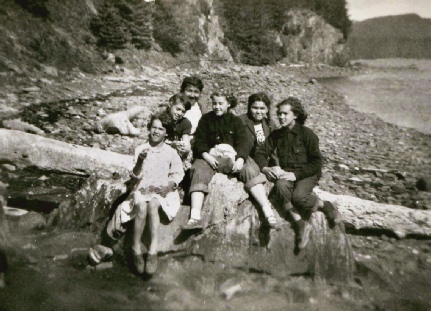
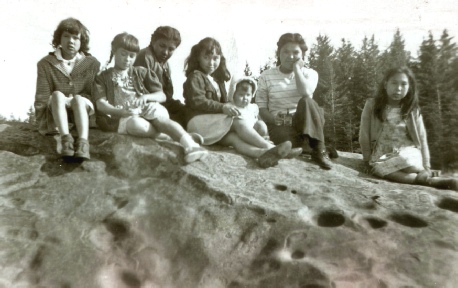
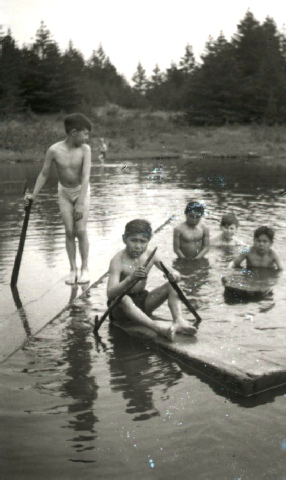
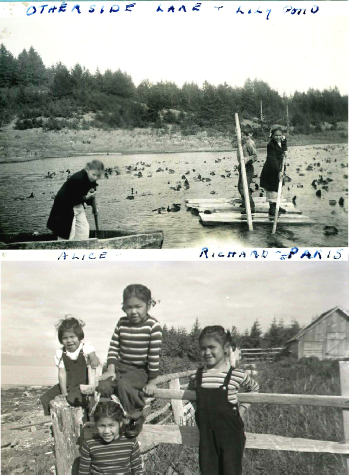
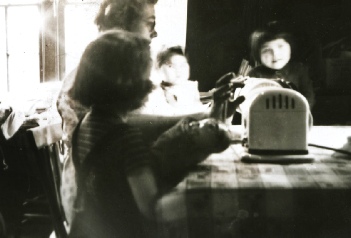
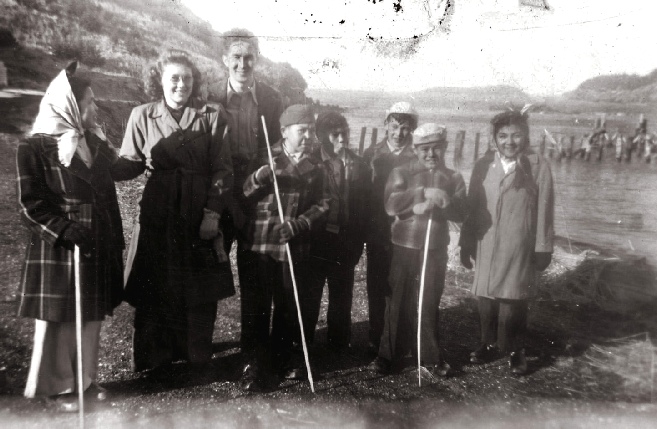
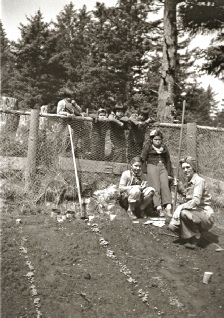
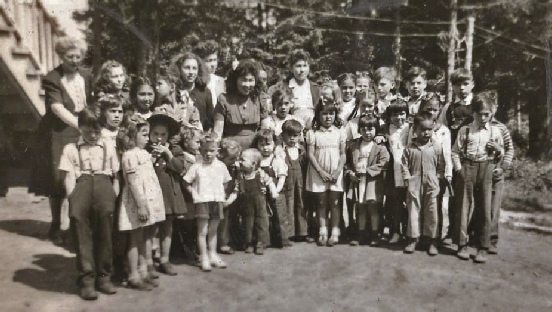

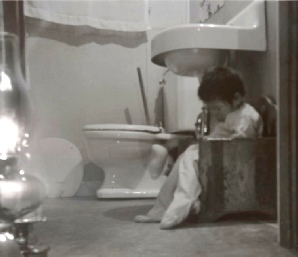
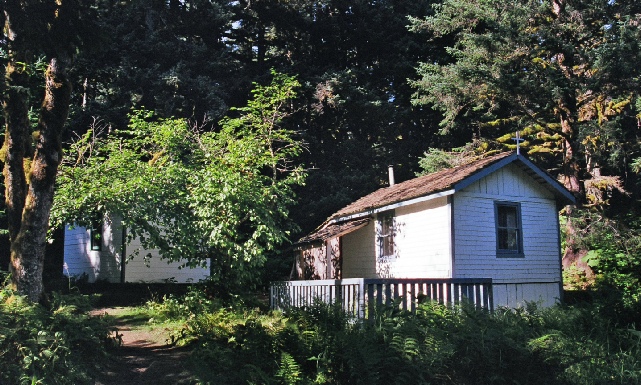
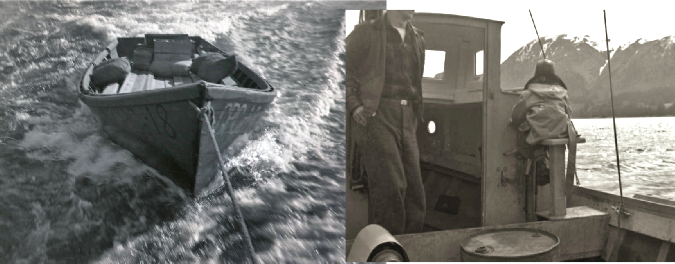
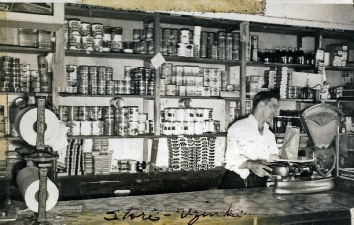
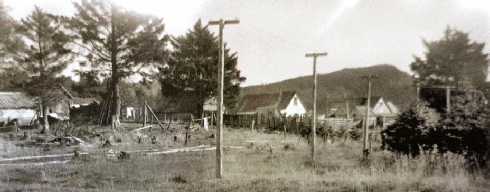
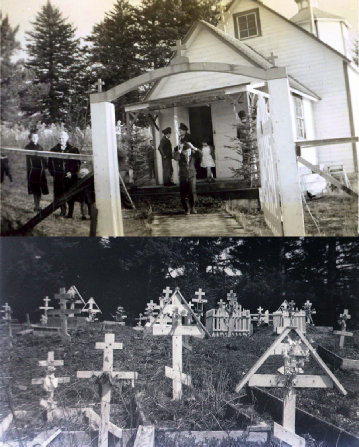
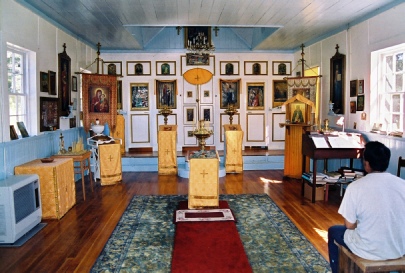
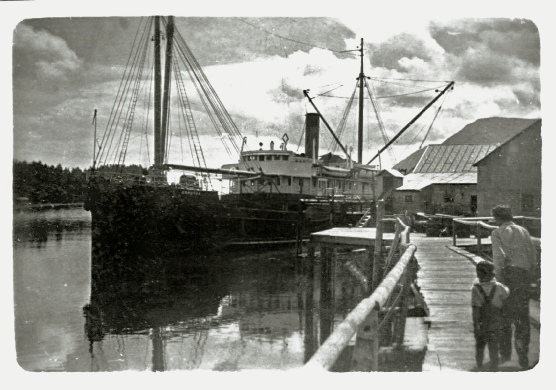
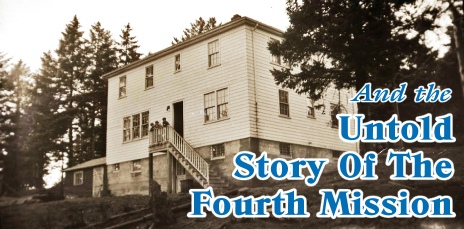

This article combines two previous ones, using old photos to show what the village of Ouzinkie was like in the 1940’s, and telling the “untold story of the fourth Mission.” Baker Cottage Baptist Mission was the only children’s home to be built in a village, and it operated from 1938 to 1958 as an orphanage.
Top: This panorama of two photos shows the Grimes Packing Company cannery from the shore, with the walkway covered in nets to the left. A corner of the farthest left cannery building is just visible in the previous shot (KBM collection).
Bottom: Baker Cottage as it looked from 1938 to 1951, without the chapel addition
and framed-
Baker joined Ayer, McWhinnie and Doane cottages in Kodiak as the fourth home of the Kodiak Baptist Mission. The buildings were built and occupied in 1938 after fire destroyed the main building on Woody Island, where the orphanage had been since 1893.
Old Ouzinkie and the Fourth Mission
By Timothy Smith, posted in 2008, latest revision in March, 2020
“An Old Ouzinkie Photo Album” and the
“Untold Story of the Fourth Mission”
A Combined Photo Album showing Ouzinkie, its People,
And the Baptist Mission Orphanage in the 1940’s,
Using Old Photo Scrapbooks from the Era
Introduction to the Combined Ouzinkie and Fourth Mission Articles, 2020
The photos in the two sections of this article all came from the same two scrapbooks
put together by house parents at Baker Cottage Baptist Mission in Ouzinkie, Alaska,
in the mid-
When I look at my photos taken in the 1960’s and early 70’s, I get the same feeling of the passage of time. The main difference is that I remember the world that I saw, and these photos are of an even earlier time, but in the exact same places where I grew up. So as a contribution to preserve the heritage of Ouzinkie, of which the Baptist orphanage is a part, here are these fascinating photographs of Ouzinkie in the 1940’s.
Occasionally I have inserted a more current photo along with a historic one, for contrast. For me, that approach gives an almost “ghosts of the past” feeling to places that are very familiar. But it may be of interest to others, because in some cases, even the newer photos are now historic.
Original 2008 Introduction to the “Old Ouzinkie Photo Album:”
This photo essay makes use of scrapbooks provided by Miss Pearl Rold and Miss Jean Lund, who were house parents at Baker Cottage (“The Mission”) in the 1940’s. Dad (Rev. Norman Smith) began photographing Ouzinkie in 1951, and we have an extensive collection of photos from then on, most of which have been used in other articles on this site. But photos from before that time are extremely rare, so we are very fortunate that the scrapbooks were unearthed and that I was able to scan and preserve these wonderful photos. Come view a world that for the most part no longer exists, a village in remote Alaska, before satellites, phones, roads, city water, and regular electricity. It was a place that a lot of terrific people called home. And still do! – Timothy Smith, March, 2008 and March, 2020
NOTE: Some historic photos show their original fades and stains.
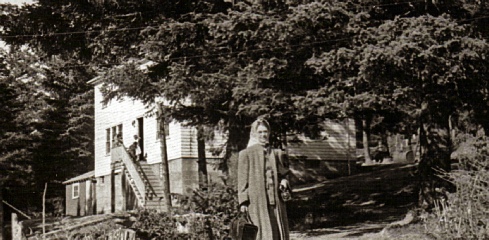
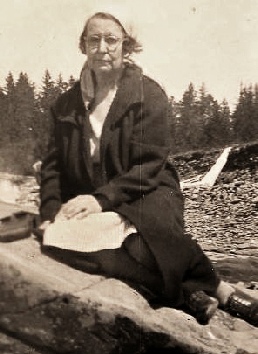
Scenes of a Village and its People, mid-
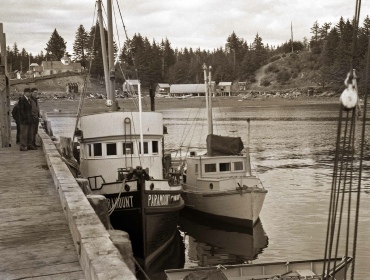
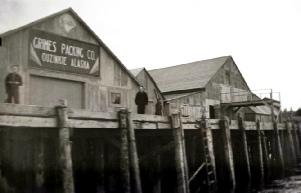

Left: the “face of the dock” looking toward the church hill. Below: the same location from the deck of a boat. Notice the Grimes cannery logo.
Above: a view of the cannery between the houses, taken from the church hill. Left: Arthur Haakanson on the dock with the store (marked X) behind him. Below: turning 180 degrees would give you this view (which I’ve used before on this site) of the Grimes cannery looking toward the mouth of the bay, with the SS Cordova.
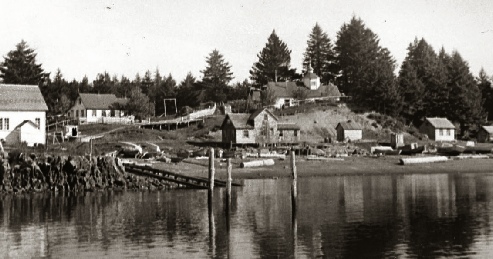
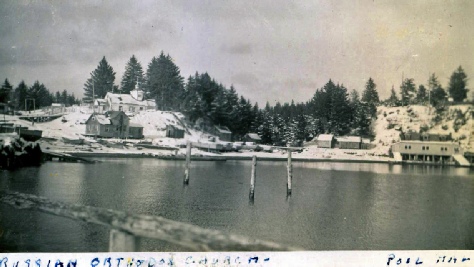
Top and right: Two views of the shoreline of the bay, one in summer, and one in winter. The bottom photo identifies the building on the far right as the “pool hall.” There was a building behind the Squartzoff’s place, toward the school in my day, also called the “pool hall.”
Views of the Holy Nativity Russian Orthodox Church Through the Years
Below: the earliest photo of the church, from 1910, shows an enormous bell tower. Center: People leave the church after a service. There are military personnel and children among others. There seems to be no bell tower. Bottom: the cemetery as it looked in the 1940’s.
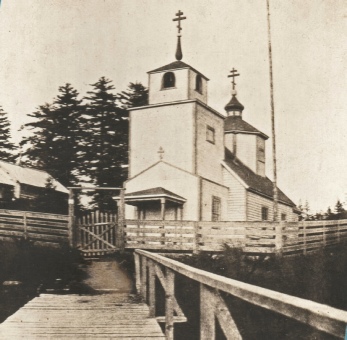
Below Left, Right: A full view of the church in 1945, and a full view in 2005 (as it’s being restored). Bottom Left, Right: an interior view from the 1940’s , and in 2005.
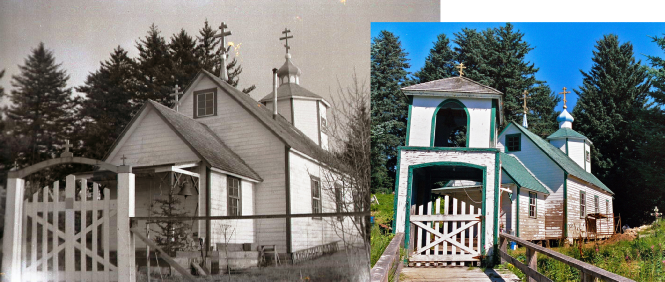
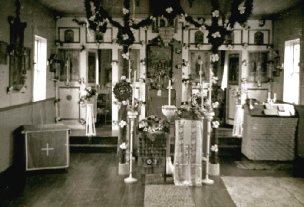
The Ouzinkie Grade School in the 1940’s
Left: The school yard featured this large antenna array in the 1940’s. Right: looking almost identical to the school as I began attending it in 1959, except with no fenced side yard. The “platform” to give a play area in the swampy areas wasn’t built until the 1950’s. Below: a view toward the center of town from the schoolyard. (The town was excited about the new power lines going in from the cannery’s generators).
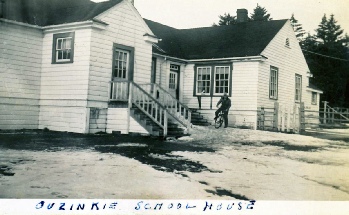

Scenes of Downtown Ouzinkie
Left: The center of city social life during the daytime was the cannery store, seen here in a photo from around 1950. In the late 1950’s additions to the left and out into the bay were built. The home visible between the buildings is the cannery superintendent’s house. The building corner we see on the far left was obviously built with scrounged WW II lumber, probably from the observation post at Doctor’s River. Right: an undated interior shot purports to be the interior of the “store Uzinki” – using the old spelling.
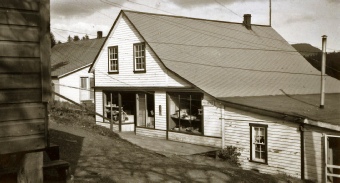
Left: Looking left as you leave the store, with the cottonwoods barely visible. Right: Looking right from the store shows the church hill and surrounding houses. Bottom: the view from the middle of the above photo, looking away from the bay, shows Ouzinkie’s old trademark boardwalks, which were a main feature until roads were built in the 1970’s.
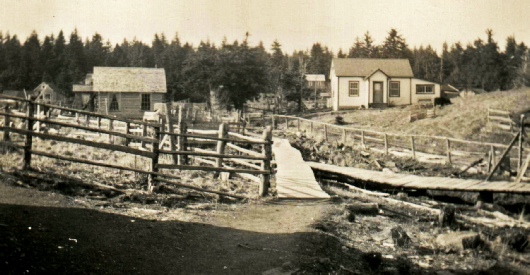
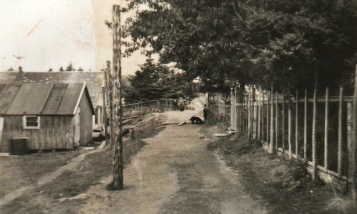
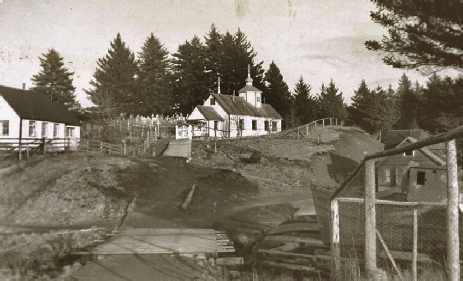
A Remarkable Journey to Monk’s Lagoon
What Miss Jean O. Lund Experienced (and Shared With Us)
A work party from Ouzinkie, taking lumber and supplies to Monk’s Lagoon, became a
part of history thanks to a passenger that came along for the ride. The boat trip
recorded here, taken in October of 1945, is remarkable because Miss Jean Lund, a
short-
Her comments about Father Gerasim included praise for his magnificent flower garden,
her sense of the peace and serenity that surrounded the chapel and the shrine, and
a Protestant’s opinion that he should spend less time in Monk’s Lagoon and more time
in Ouzinkie, “because his people need him.” It’s clear that her overall impression
was positive, and that she saw the Monk-
Top: the fishing boats and skiffs head out toward Monks Lagoon. Center Left: The GPC 18’s skiff laden with lumber and other supplies, in tow. Center Right: a boy takes the helm under the proud eye of his father. Bottom: a woman on the pilgrimage rests on the journey.
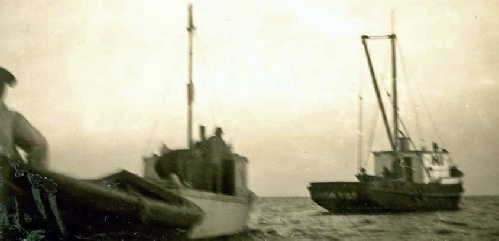
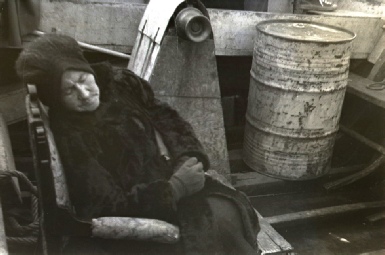
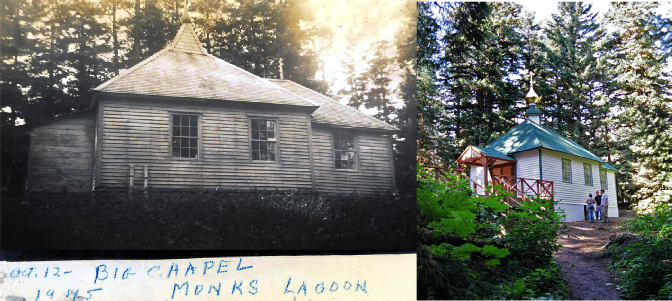
Above Left: the Shrine and Burial Place of Herman of Alaska, 1945. Above Right: the Shrine in honor of Saint Herman of Alaska, 2004. Monk’s Lagoon, Spruce Island, Alaska
Below: Two remarkable photos of the hermitage at Monk’s Lagoon, with Father Gerasim
graciously posing for Miss Lund’s camera, October, 1945. The differences in coloration
is because one photo is from Miss Lund’s scrapbook, and the other is from a negative
found in Baker Cottage’s darkroom in the mid-
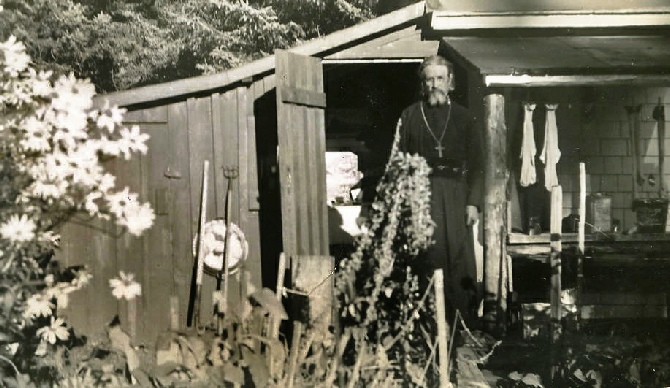
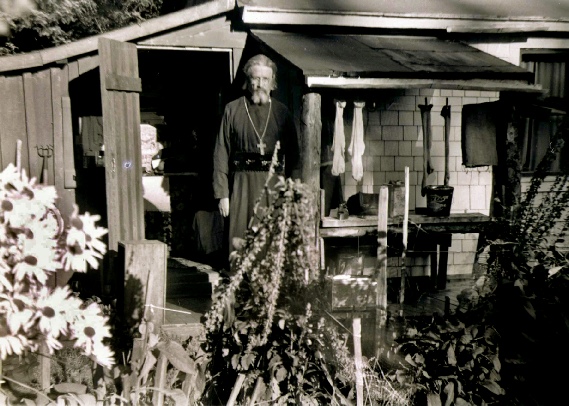

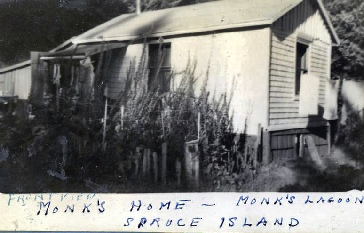
Above Left: the small chapel at Monk’s Lagoon, with a stack of driftwood nearby. A slightly fogged negative gives the ghostly, smoky artifact above the chapel. Top Right: Father Gerasim’s quarters at Monk’s Lagoon, 1945. Below: both buildings in 2004, carefully restored and reverently preserved. Below: Alice and Pearl are ready to leave Monk’s Lagoon, but I’m afraid everybody will have to drag the dory to the water, because the tide has gone out since they arrived!
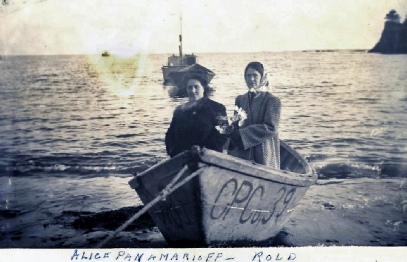
The People of Ouzinkie, Out and About
Below Left: Bill Torsen rows a skiff full of young people out in the Ouzinkie Narrows, 1946. Below Right: Village boys don’t let snow keep them from biking.
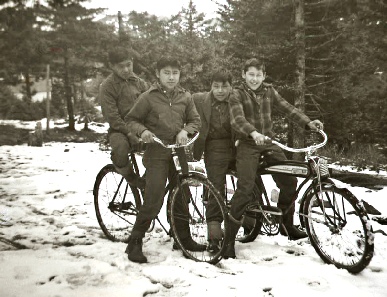
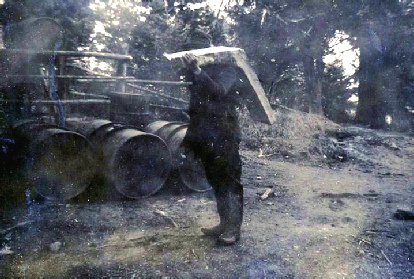
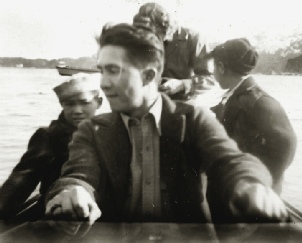
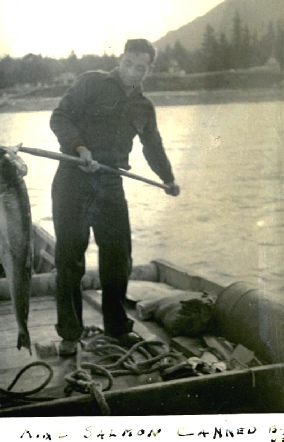

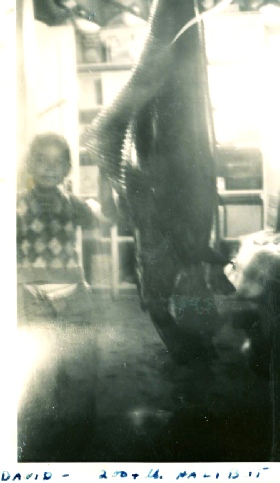
Top Left: George Panamarioff carries a spruce “knee” cut from the trunk and roots of a tree, which will be sliced to make skiff ribs. Top Right: Tim Panamarioff, Senior in 1945 with a huge salmon he has caught. Tim passed in the fall of 2006, in his 90’s!
Below Left: Mrs. Pestrikoff and her kids, in front of their house. Below Right: David poses next to a 200 lb halibut!
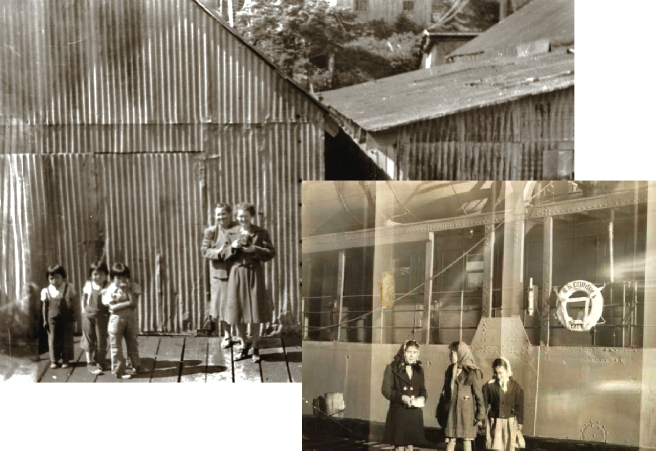
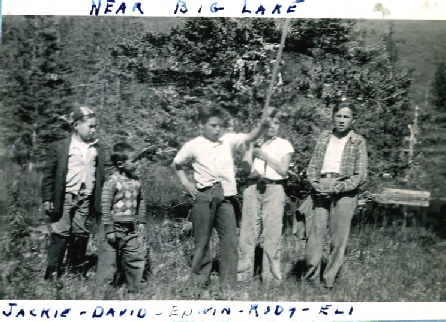
Left: an unknown group of people say goodbye on the Grimes Packing Co. dock. Right: Claudia, Betty, and Tiny greet the SS Cordova. Below: a group of boys hike to Mahoona (Big) Lake.
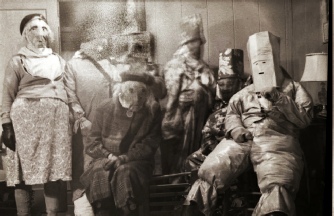
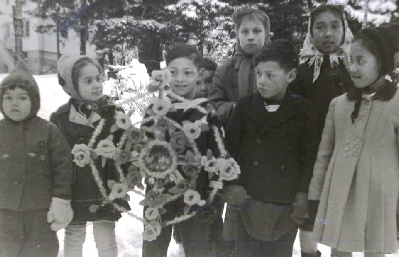
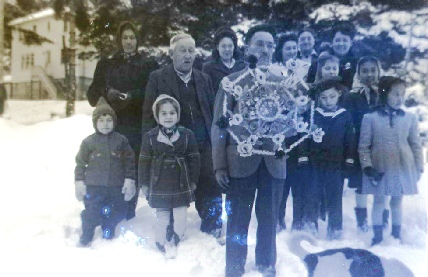
Above and Right: Two scanned negatives of the Orthodox custom of “Starring,” singing Christmas carols (mostly in Russian) while twirling the star and facing a holy picture (icon). This group is below the Mission. The photo on the right is only the kids! Below: After Russian Christmas, maskers (muskaraduks) dress in masks and costumes to scare away the Devil and Herod’s men who are trying to kill the baby Jesus. This is the only photo I’ve seen of this village custom.
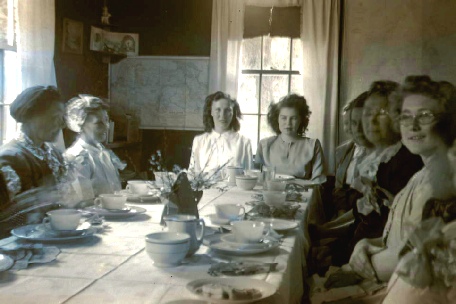
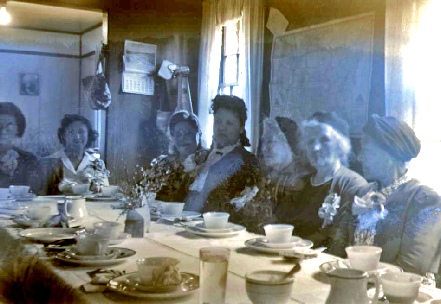
Left and Below: A ladies’ tea at the Mission, from old negatives found in a box. The negatives have weird color cast when scanned in color because of insufficient chemical processing back in the 1940’s. It makes a nice effect!
Mary Setzekorn, “Setze,” had many outreaches to the people of the village, besides running a busy children’s home. Setze was also a nurse, and led a Sunday School in the large upstairs room in the Mission. The story of the Mission follows below.
The Untold Story of the Fourth Mission
Original 2008 Introduction to “The Untold Story of the Fourth Mission”
Notes and Acknowledgements: This is the previously untold story of the fourth mission, told now (mostly) through photos of the people and activities of Baker Cottage during its twenty years as an orphanage. I am indebted to Pearl Rold and Jean O. Lund for their scrapbooks from the 1940’s, which were found in the collection of Rev. Norman Smith, my father, when he passed away in 1996. I am also indebted to the late Beryl (Butler) Torsen, a close friend of our family, who was a house parent in Ouzinkie during the 1940’s, and shared some fascinating stories with me. For an account of our visits to Baker Cottage during the 1950’s, please see the article: “The Evangel Visits Ouzinkie in the 1950’s.” For a list of articles involving Ouzinkie Grade School, Baker Cottage, and village life in the 1960’s (when I was living there), return to the Ouzinkie Index page. Any assistance in identifying unknown persons in the photographs is greatly appreciated!
Additional Notes, 2020
This part of our combined article contains more text, including wonderful things I could not write in 2008 because the principals were still living. But Baker Cottage Baptist Mission has had a Christian witness in Ouzinkie since 1938, with 48 of those years being the ministry of my parents, Revs. Norman and Joyce Smith. The story of the fourth mission is all before I moved there, while it was a children’s home. As I indicated above, I’m indebted to the scrapbooks I found in the Mission archives, to the stories passed down to me by my parents, and to Beryl Torsen, who worked as a house parent at Baker Cottage in the postwar years.
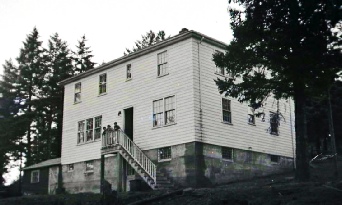
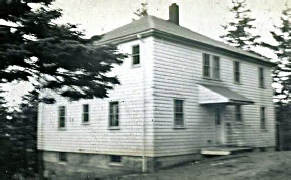
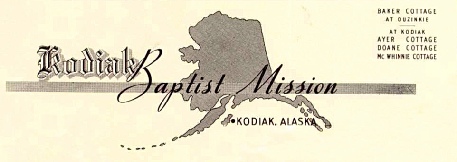
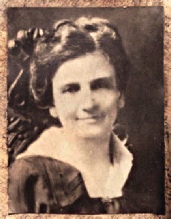
Top: Baker Cottage from the front and the back on the side that faces the main part of town, 1940’s. Below Left: the KBM letterhead, with Baker Cottage Ouzinkie at the top right. The portrait is of missionary volunteer and philanthropist Abby Gunn Baker, the building’s namesake, from a plaque that hung in Dad’s office for years.
Baker Cottage in the War Years
When the Mission began operation in Ouzinkie in 1938, it was part of the new group of Baptist orphanages constructed after the main building on Woody Island burned down. Three cottages were constructed in Kodiak, and Baker Cottage was built in Ouzinkie, two hours away by fishing boat. There were plans for several more orphanages around Kodiak Island, but Baker Cottage ended up as the only village orphanage.
When World War II hit, Baker Cottage had an important role. Since the buildings in Kodiak were close to several military targets, it was decided that only older kids would be housed there. A bomb shelter had been built in the forest behind the Kodiak Mission buildings, above where the hospital is now, and the older kids practiced evacuating to the shelter regularly during the war. But Baker Cottage in Ouzinkie housed all the little kids, because it was in a village that had no military targets nearby. Even though Ouzinkie was considerably more remote then than it is now, it was still considered safer for the little ones during wartime. So Baker was not just an orphanage, it was often a nursery!
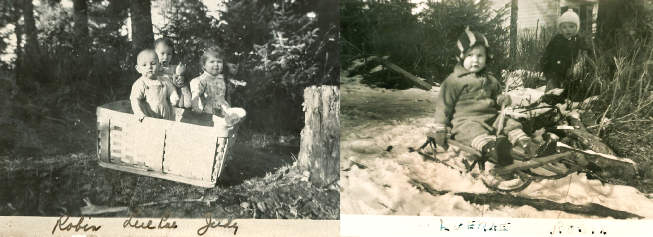
Top and Right: Baker Cottage’s kids during the War years, all young people. Note the little guy wh fell asleep on the potty chair!
From the scrapbooks, it was common for the kids to go on outings and engage in a
lot of free-
The Adults of Baker Cottage (What is Known about the Staff)
“Setze”
Miss Mary Setzekorn, called “Setze” by those who knew her, was house parent in Baker Cottage in Ouzinkie for most of its tenure as an orphanage. She was also a registered nurse, and served the entire community in that capacity, even joining the Public Health Services crew aboard the M/V Hygiene, which traveled around the island to the villages and canneries in the early 1950’s. She also was a dedicated missionary, who held worship services and began a Sunday School in the large upstairs room (the future kindergarten classroom of Joyce Smith) during her years there. The photos of the ladies’ tea document another of her outreaches to the community. There was also a Boy Scout troop sponsored by the Mission. When we moved to Ouzinkie in 1958, we found the village well prepared for the kind of ministry my parents initiated, thanks to the work of “Miss Setze.”
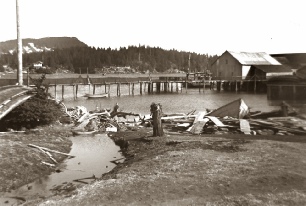
Above Left: the “Baker Kids” clamber all over a big skiff in downtown Ouzinkie near the cannery during the War years (reference the bay photo on the right from the same spot).
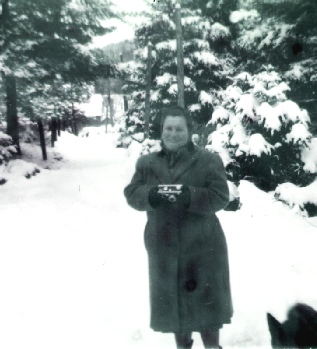
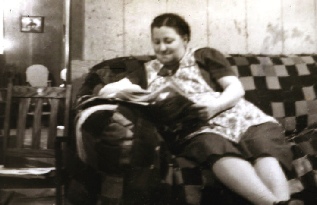
Right: Setze and her trusty Argus C3 slide camera on the trail below the Mission. Below: Setze getting a moment’s rest in Baker’s living room. Alas, none of Setze’s slides have come my way. They’d be spectacular! A high chair is visible in the distance. Bottom Photos: the Ouzinkie Sunday School led by Setze included a lot of local kids as well. And Miss Rold relaxes a bit on the living room couch.
The Adults of Baker Cottage (What is Known about the Staff)
Pearl Rold and Jean Lund, and Daily Life in Baker Cottage
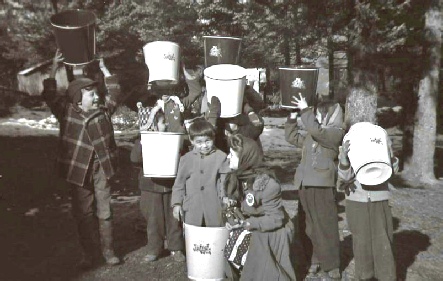

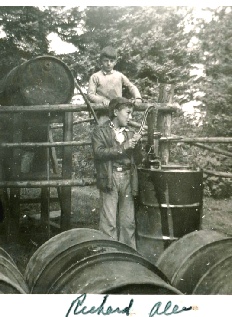
The Baker Kids Help With the Chores
Top Left: three girls sweep up after taking down the Christmas tree, with needles,
cotton “snow” flocking, and ornaments all in piles. Top Right: Miss Rold, camera
at the ready, clowns around with the young Baker kids who have just emptied their
trash baskets into an empty oil barrel incinerator in the back yard. Center: Miss
Rold and the Baker kids grow a garden. Left: free-
A Baker Cottage Love Story
Beryl Torsen was just another adult in Ouzinkie when I moved there, her husband Bill being one of the better local fishermen. But she was also my Sunday School teacher, to help out my parents. I later discovered that she had actually been a house parent at Baker Cottage, starting around 1947. She told me a lot of stories about serving in that capacity, but it wasn’t until years later that she shared how she and Bill Torsen had met and fell in love. In the context of the strict rules of Baptist missionary protocol, the tale had Romeo and Juliet overtones to it. When Beryl (Butler at the time) came to Baker Cottage, she met a young man named Bill who often helped take the Baker youngsters on skiff rides in the bay, or hikes through the woods to distant lakes and beaches.
It didn’t take long before she became interested in him, and he with her. In our day, we can guarantee that they were models of decorum. But as a Baptist female missionary with implied but enforced spinsterhood, she was breaking all the norms. Her bedroom, the one just over the kitchen, was also my bedroom later through grade school. Its window looked out partially over the back porch roof. Toward the end of her life, Beryl related that she would punch a hole in an empty tin can, tie a string to the can, and prop it up in the window of her bedroom. When Bill wanted to see her after hours, in private, he would pull on the string, and that would be Beryl’s signal to sneak out across the back porch roof.
When Bill and Beryl went public and got married, it took many years before Beryl was allowed to work as a substitute house parent. By that time, the young Torsen family had moved to Kodiak, and there was a new superintendent at the Mission there, who thought the prohibition was as silly as it sounds to us now. So Miss Beryl Butler, who became Mrs. Bill Torsen, gave up a lot for love. But they were stalwart members of the community to the end of their lives, and Beryl Torsen became one of the indispensable volunteers at Camp Woody (chronicled in this site in those articles) and one of the real heroes of that ministry. Bill, besides running the FAA’s boat the Fedair IV for years, ran his own boat the Voyager and pioneered new (for Kodiak) seafood crops such as scallops, as one of the most respected fishermen in the Kodiak fleet.
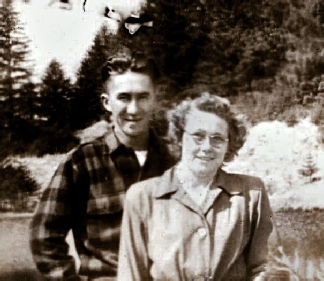
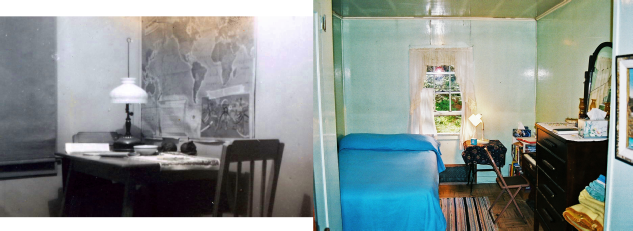

Top Left: Bill and Beryl in 1947. Top Right: Beryl and Bill in their home on the bluff overlooking the Kodiak channel, 2004. Bottom Left: Beryl’s bedroom in Baker Cottage, 1940’s. Bottom Right: Beryl’s bedroom (and later mine) in 2005, the famous window open (but no tin can in sight!)
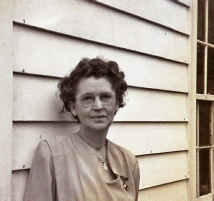
Above: First we pay tribute to one of the primary photographers, Miss Pearl Rold, shown here standing in front of the “fat tree,” down the trail from the Mission, and standing on the front porch of Baker Cottage, circa 1943.
As a point of trivia, the first summer that my Dad, Rev. Norman L. Smith, piloted the mission boat Evangel around Kodiak Island, my Mom, Joyce Smith, was assigned as a replacement house parent for Pearl Rold, who went to visit relatives in the “Lover 48.”
Left: the other photographer, Miss Jean Lund, served at Baker Cottage for only ten months, from 1945 to 1946, but documented almost everything she saw, including a memorable visit to Monk’s Lagoon, where she met Father Gerasim Schmaltz. Here she is on the famed Otherside rock spot.
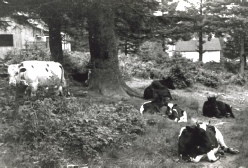

The Last Decade of the Orphanage
In the postwar years, the orphanage in Ouzinkie housed a more diverse group of children. That
meant older kids, and fewer of the really young ones, who without any threat of war,
would be better served close to doctors and the hospital. One of the postwar house
parents was Beryl Butler, some of whose story I just shared. Among other well-
The two scrapbooks, from Jean Lund’s prolific descriptions of her 10-
When the chapel extension was built off the basement in 1952, my father, Rev. Norman Smith, preached the dedication service. Just another task for the only ordained minister among the Baptist missionaries. As the article, “The Evangel visits Ouzinkie in the 1950’s” makes clear, we loved calling on Ouzinkie and Baker Cottage in particular on our journeys around the island while based in Larsen Bay. I’m sure Dad never dreamed that Ouzinkie would soon be their last home, and that the chapel he dedicated in 1952 would one day be the site of both his and his wife’s memorial services. Their legacy extended much longer than that of the orphanage, which used Baker Cottage for about twenty years. Mom and Dad were privileged to serve Ouzinkie from Baker Cottage for almost fifty years.
The Active Occupants of Baker Cottage: A Photo Scrapbook
Top Left: Beryl teaches sewing to a group of young girls. Top Right: Beryl, Bill, Miss Rold, and kids playing in the snow. Bottom: Bill and Beryl (an an unidentified woman) take the older kids on a hike.
The Mission Kids Explore Otherside Lake and Beach, and Then Hike to Sourdough’s Flats
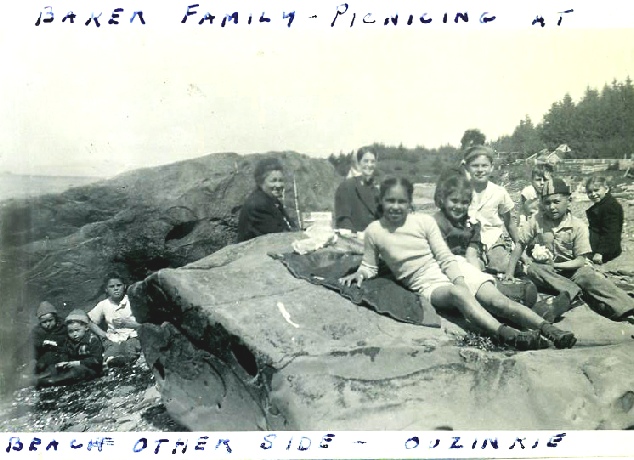
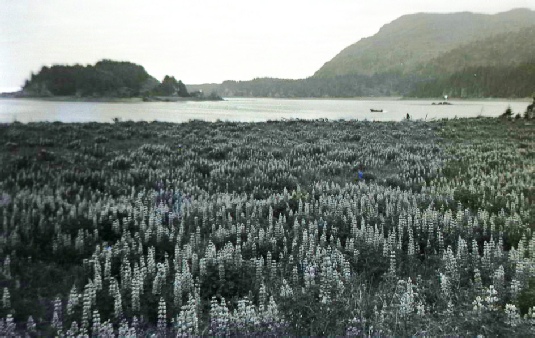
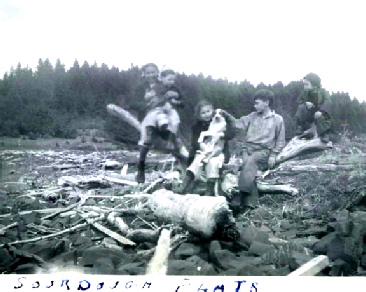
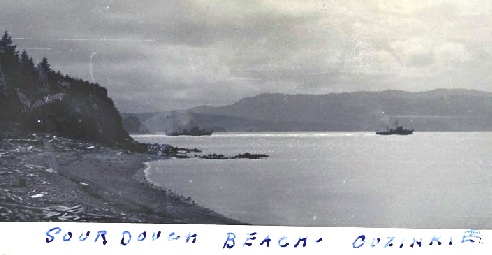
Left: Patrol boats off Sourdough Flats in 1943. The war prompted Baker Cottage to take the little kids, because it was remote, and more protected from military action.
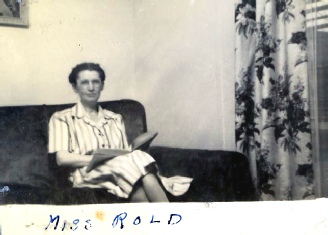
From living in Baker Cottage myself, less than a year after the children moved out, I can tell you how difficult a house parent’s life was in those days. First, the furnace was a coal fired burner with no fan and no thermostat, meaning heat distribution was dependent on the skill of the person with the bucket and scuttle. The other main source of heat, the oil stove in the kitchen, worked against the cook if the weather was warm, because you couldn’t fry or boil or bake without turning up the stove, and then you’d fry or boil or bake yourself trying to make dinner.
Washing clothes involved an ancient water heater that gave out after a few minutes
of heated water. In fact, paperwork I read in the KBM archives in Kodiak indicated
that Mr. Grimes of the Grimes cannery in the village sold (not gave) a water heater
to Baker Cottage, and that it immediately broke or came broken. Given that three
women busy with a house full of little children were not also plumbers and mechanics,
it meant many days of cold water until someone came and repaired it. Now once you
got all those clothes washed, you still had to hang them all indoors on the wires
strung down the ceilings of both the upstairs and downstairs hallways. Finally there’s
food storage: it was mostly canned or dried or otherwise un-
Obviously, Depression-
Pearl Rold also worked at Baker Cottage for most of its service as an orphanage,
but because she did not have any correspondence that survived in the scrapbooks I
have, I know very little about her. I know that my Mom, Joyce Smith, first served
in the summer of 1951 as a replacement house parent for Miss Rold when she went home
to the States to visit family. But her scrapbook of photos survives, and from that
I see a caretaker who was stern-
This rare book was based loosely on a child’s experience in Baker Cottage. It was
published in 1957. The cover and interior artwork bore little resemblance to the
real buildings, and the plot was pure cringe-
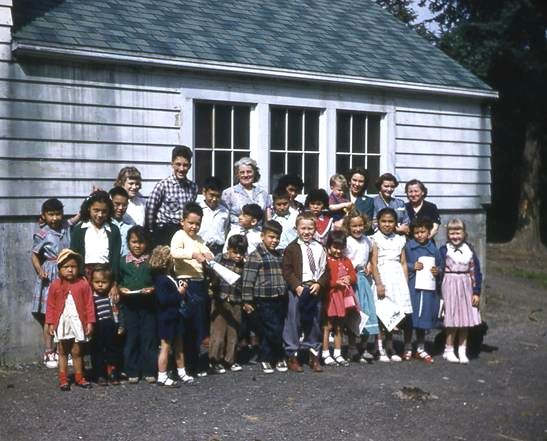
The crew of the Mission’s Vacation Bible School, including the Smith family and many local kids, pose for Dad’s camera in the summer of 1957, one year before the orphanage was closed and we moved into Baker Cottage.
Some notable faces: back row has my sister Jerilynn standing next to Noel (checkered shirt). In the center, with white hair, is Mildred Crowell, house parent at Ouzinkie for many years. I’m the little guy in Mom’s arms, looking down.
At the far right end in the rear is Mary Setzekorn, who had served in Ouzinkie since the War years. In the front row, the young man in the yellow shirt, waving a paper, is Jerry Gugel, Jr., who has been a missionary in Alaska for many years, with his sister Nancy looking up at him to his right.
The young man wearing a tie, and the girl on the far right in a dress are the children of Beryl (Butler) Torsen, who was house parent at Baker Cottage during the late 1940’s, and Bill Torsen, from Ouzinkie (see earlier in the article).
The young lady in the white top and turquoise dress is my older sister Robin. I also see several Squartzoff children, but the rest are unidentified. If you care to help me, send an email.
Below: the author on the Otherside rock, seen in many photos in this article, in 2005.
Epilogue to “The Untold Story of the Fourth Mission”
Every now and then I get emails from people who spent part of their youth in Baker
Cottage, or tell me that one of their parents did. I have also heard from relatives
of several of the house parents over the years. The old-
Conclusion to the Combined Articles
I hope you’ve enjoyed this window to the past. There are many more photos in each
section of this edition than before, and every one has been restored. I let the natural
fading and discoloration of negatives and prints shine through, and for those photos
that were “ok,” I tinted them slightly to match the rest of them. And I think the
addition of more current photos helps to tell even more of the story. There are many
photos here of events and situations that are not published anywhere else. Should
you wish to use any for non-
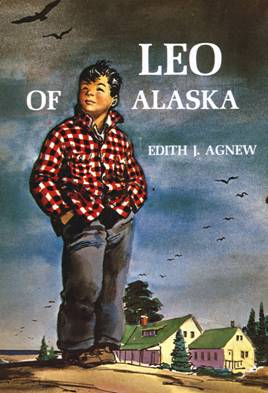
For Tim’s articles on the village of Ouzinkie, the voyages of the Evangel, or Kodiak Transportation (Such as Kodiak Airways and PNA),
including many more historic photos,
please follow the links in the graphics below.

To Find Out More About Tanignak.com, Click HERE
To Visit My “About Me” Page, Click HERE
To Return to Tanignak “Home,” Click the Logo Below:
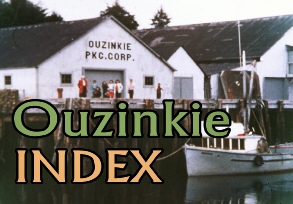



Information from this site can be used for non-

